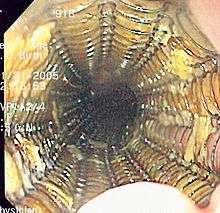Esophageal stent


An esophageal stent is a stent (tube) placed in the esophagus to keep a blocked area open so the patient can swallow soft food and liquids. Esophageal stents may be self-expandable metallic stents, or made of plastic, or silicone, and may be used in the treatment of esophageal cancer.
A 2007 study showed no difference in the quality of palliation between plastic and metal stents, but a novel polyester mesh stent caused more complications, especially migration.[1]
As of 2009, covered self-expanding metal stents were the only FDA-approved to be placed permanently. Occasionally, these stents may be placed as part of a clinical trial or as off-label use to repair esophageal leaks or fistulae. They are placed using the guidance of fluoroscopy (x-ray) and endoscopy. Usually, they are left in for less than four weeks.
References
- ↑ Conio M, Repici A, Battaglia G, et al. (2007). "A randomized prospective comparison of self-expandable plastic stents and partially covered self-expandable metal stents in the palliation of malignant esophageal Dysphagia". Am. J. Gastroenterol. 102 (12): 2667–77. doi:10.1111/j.1572-0241.2007.01565.x. PMID 18042102.
External links
- Esophageal stent entry in the public domain NCI Dictionary of Cancer Terms
![]() This article incorporates public domain material from the U.S. National Cancer Institute document "Dictionary of Cancer Terms".
This article incorporates public domain material from the U.S. National Cancer Institute document "Dictionary of Cancer Terms".